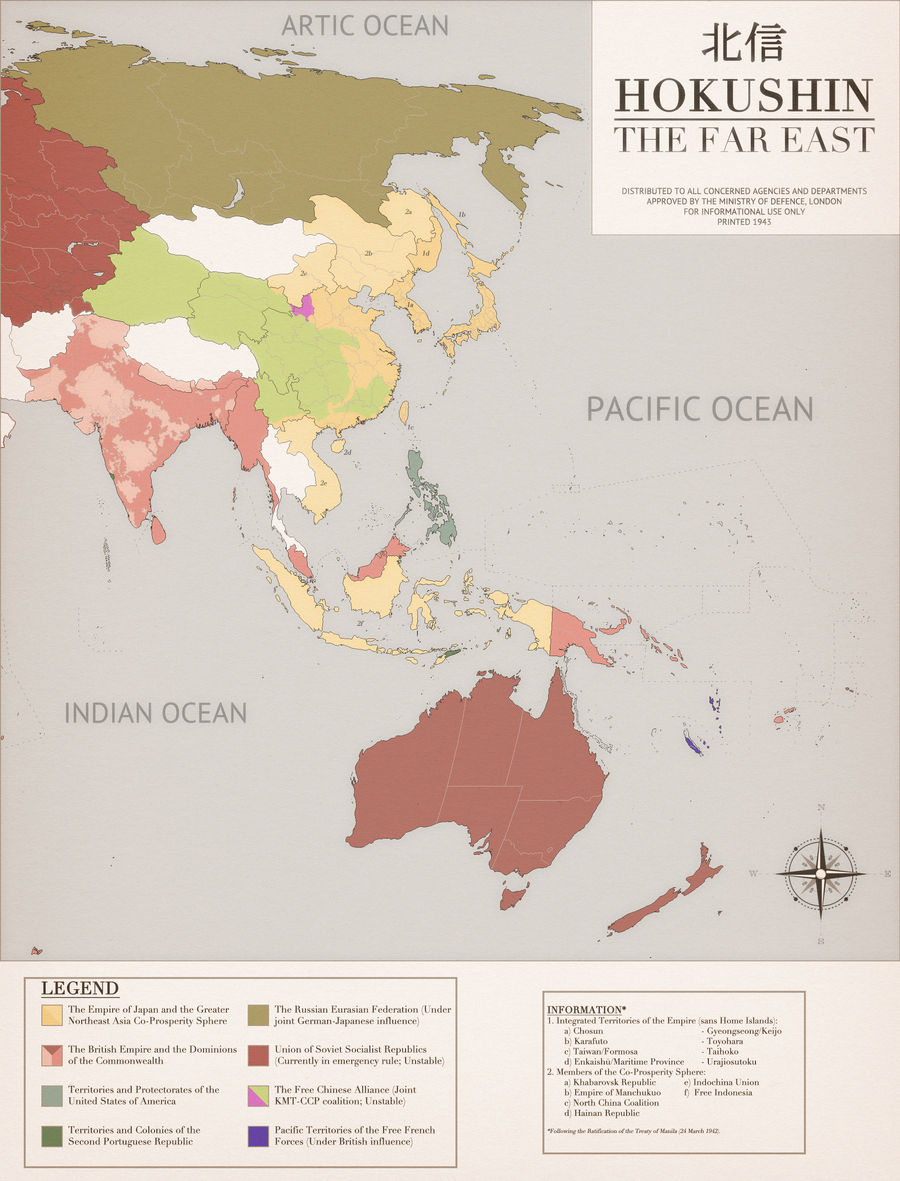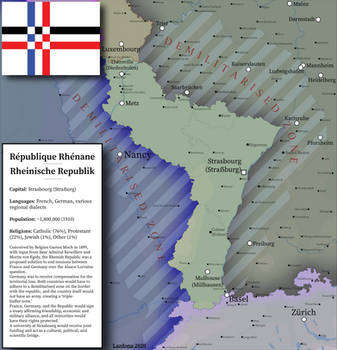ShopDreamUp AI ArtDreamUp
Deviation Actions
Description
Here's something of a surprise map-profile that I've been working on over the past two days. This one focuses on an alternate history scenario based on Peter Tsouras' Rising Sun Victorious ([link]): namely that (among other things) instead of taking on the British and Americans, Japan fights the Soviet Union, resulting in a VERY different Pacific War.
Mapwise, I've been toying with a few different techniques and designs. Though if there's any glaring flaw, it would have to be a certain typo there that was only found too late.
Still, comments and critiques are appreciated. And as a precaution, this is NOT propaganda, revisionist history or an anti-Chinese screed at all.
-----
The conflict that soon came to be called the “Second Russo-Japanese War” was one of the great upsets in recent history. Although the conflict could be described as merely an opportunistic, if not lucky blow in conjunction with the relentless advances of Germany, it is nonetheless recognized that the island nation had done what was once thought to be impossible: dealing a striking victory against the expansive Soviet Union. The move to push forward with the Hokushin (“Go North”) strategy turned out to be decisive moment for Japan that would have large repercussions for Asia and the rest of the world.
At first, however, success was not guaranteed. The humiliating Nomonhan Border Incident of 1939 prompted the country’s military leaders to revise what was at the time called Hachi-Go (Operation Plan #8): a plan to reach Lake Baikal in an attempt to cut off the Soviet Far East from the rest of the USSR. After several revisions and the input from defecting NKVD chief Gen. Genrikh Samoelovich Lyushkov (later governor of the Empire’s Maritime Province), the plan now called Hokushin would commit the majority of the Imperial Japanese forces in a concerted attack along the Manchukuo border towards the directions of Vladivostok (later renamed Urajiosutoku) and Khabarovsk. But from the very beginning, the Japanese considered such a move as a means to not only secure the wealth of Siberia but also contain if not crush the Bolshevist threat.
Originally the plans were set for 1943, but with increasing pressure from the United States and Britain for their ongoing conflict in China the authorities grew cautious over possible embargoes that would cripple the war effort. The situation changed when in March 1941, Foreign Minister Yosuke Matsuoka and Gen. Hiroshi Oshima were informed of Hitler’s proposal for a joint attack alongside what came to be known as Operation Barbarossa. Coupled with the Soviets mobilizing many Siberian garrisons away to fight the Nazis gave Japan an enticing opportunity. Which came on the 7th of August, 1941 with a surprise aerial attack on Vladivostok.
Although many of the replacements were drafted from peasants and gulag prisioners by order of Gen. Apanasenko, the Soviets for a time were able to hold off the initial attacks by the Japanese. But after several costly but relentless assaults, holes in the front line opened, allowing the invading forces to swarm across the border and secure sections of the Trans-Siberian Railway. While “Yamato spirit” and “samurai valor” were claimed in to have won the day, in reality these were supplemented by close supply lines and air superiority that soon made quick work of the remaining Russian tanks. Vladivostok fell in September of the same year, forcing what remained of the Red Army north to defend the road to Khabarovsk.
By the time the Japanese entered Khabarovsk in December, however, Moscow fell to German hands, many of the Siberian reinforcements having been long wiped out in defending Kiev and other failed safe zones. With limited resources control and Stalin’s disappearance (his last sighting being somewhere in Kazakhstan, his power long evaporated), the USSR plunged into chaos. Cut off from the rest of Russia, Siberia rose in open revolt (in part through both German and Japanese covert aid) becoming the nucleus of the Russian Eurasian Federation. What remained of the Soviet Union fell under martial law as several officers attempted to restore order while simultaneously fighting off both themselves and the Axis Powers: a campaign that foreign observes deem as doomed to fail.
But what ultimately secured victory was the Treaty of Manila in March 1942, which had been sponsored reluctantly by US President Franklin Roosevelt in what some called a shameless act of realpolitik. British and American interests, including their territories were secured (which served to be a godsend to the Crown following the failed invasion of the British Isles in 1943) at the expense of deliberately turning a blind eye at Japan’s continuing moves against China; with Nazi Germany having effective control over much of Continental Europe, the Allies deemed fighting Hitler to be the main priority. For the Japanese, they had not only expanded their Empire but also saw vindication in once again defeating a major Western power. And with their Co-Prosperity Sphere including such lands like Indochina and Indonesia (both through German support), their time in the sun had only just begun, though there were soon rumors that the Americans would push through with their oil embargo. Not that it would help much, but some still wonder what would have happened had the focus been instead on Southeast Asia and its abundant resources…
Mapwise, I've been toying with a few different techniques and designs. Though if there's any glaring flaw, it would have to be a certain typo there that was only found too late.
Still, comments and critiques are appreciated. And as a precaution, this is NOT propaganda, revisionist history or an anti-Chinese screed at all.
-----
The conflict that soon came to be called the “Second Russo-Japanese War” was one of the great upsets in recent history. Although the conflict could be described as merely an opportunistic, if not lucky blow in conjunction with the relentless advances of Germany, it is nonetheless recognized that the island nation had done what was once thought to be impossible: dealing a striking victory against the expansive Soviet Union. The move to push forward with the Hokushin (“Go North”) strategy turned out to be decisive moment for Japan that would have large repercussions for Asia and the rest of the world.
At first, however, success was not guaranteed. The humiliating Nomonhan Border Incident of 1939 prompted the country’s military leaders to revise what was at the time called Hachi-Go (Operation Plan #8): a plan to reach Lake Baikal in an attempt to cut off the Soviet Far East from the rest of the USSR. After several revisions and the input from defecting NKVD chief Gen. Genrikh Samoelovich Lyushkov (later governor of the Empire’s Maritime Province), the plan now called Hokushin would commit the majority of the Imperial Japanese forces in a concerted attack along the Manchukuo border towards the directions of Vladivostok (later renamed Urajiosutoku) and Khabarovsk. But from the very beginning, the Japanese considered such a move as a means to not only secure the wealth of Siberia but also contain if not crush the Bolshevist threat.
Originally the plans were set for 1943, but with increasing pressure from the United States and Britain for their ongoing conflict in China the authorities grew cautious over possible embargoes that would cripple the war effort. The situation changed when in March 1941, Foreign Minister Yosuke Matsuoka and Gen. Hiroshi Oshima were informed of Hitler’s proposal for a joint attack alongside what came to be known as Operation Barbarossa. Coupled with the Soviets mobilizing many Siberian garrisons away to fight the Nazis gave Japan an enticing opportunity. Which came on the 7th of August, 1941 with a surprise aerial attack on Vladivostok.
Although many of the replacements were drafted from peasants and gulag prisioners by order of Gen. Apanasenko, the Soviets for a time were able to hold off the initial attacks by the Japanese. But after several costly but relentless assaults, holes in the front line opened, allowing the invading forces to swarm across the border and secure sections of the Trans-Siberian Railway. While “Yamato spirit” and “samurai valor” were claimed in to have won the day, in reality these were supplemented by close supply lines and air superiority that soon made quick work of the remaining Russian tanks. Vladivostok fell in September of the same year, forcing what remained of the Red Army north to defend the road to Khabarovsk.
By the time the Japanese entered Khabarovsk in December, however, Moscow fell to German hands, many of the Siberian reinforcements having been long wiped out in defending Kiev and other failed safe zones. With limited resources control and Stalin’s disappearance (his last sighting being somewhere in Kazakhstan, his power long evaporated), the USSR plunged into chaos. Cut off from the rest of Russia, Siberia rose in open revolt (in part through both German and Japanese covert aid) becoming the nucleus of the Russian Eurasian Federation. What remained of the Soviet Union fell under martial law as several officers attempted to restore order while simultaneously fighting off both themselves and the Axis Powers: a campaign that foreign observes deem as doomed to fail.
But what ultimately secured victory was the Treaty of Manila in March 1942, which had been sponsored reluctantly by US President Franklin Roosevelt in what some called a shameless act of realpolitik. British and American interests, including their territories were secured (which served to be a godsend to the Crown following the failed invasion of the British Isles in 1943) at the expense of deliberately turning a blind eye at Japan’s continuing moves against China; with Nazi Germany having effective control over much of Continental Europe, the Allies deemed fighting Hitler to be the main priority. For the Japanese, they had not only expanded their Empire but also saw vindication in once again defeating a major Western power. And with their Co-Prosperity Sphere including such lands like Indochina and Indonesia (both through German support), their time in the sun had only just begun, though there were soon rumors that the Americans would push through with their oil embargo. Not that it would help much, but some still wonder what would have happened had the focus been instead on Southeast Asia and its abundant resources…
Image size
1894x2484px 7.12 MB
Comments84
Join the community to add your comment. Already a deviant? Log In
This looks cool. I wish I had those artistic skills.




































